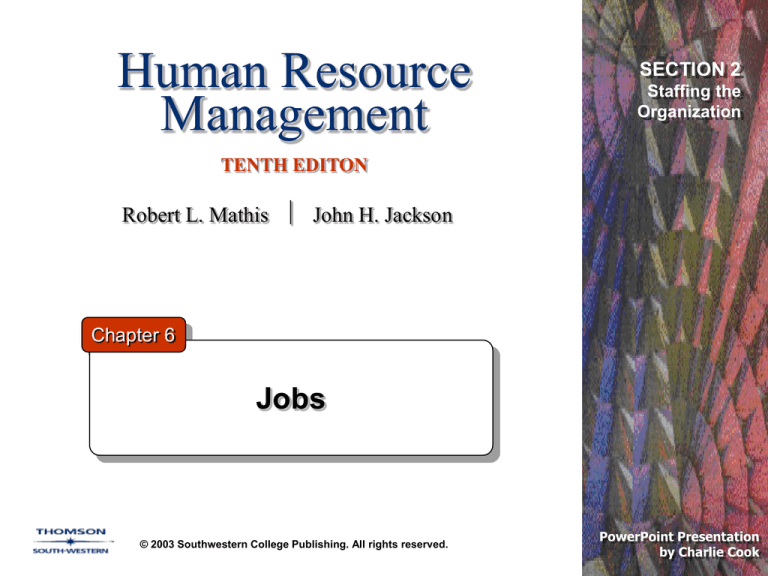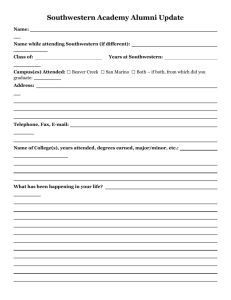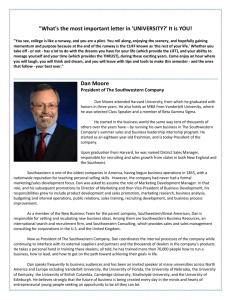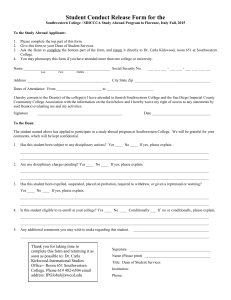
Human Resource
Management
SECTION 2
Staffing the
Organization
TENTH EDITON
Robert L. Mathis John H. Jackson
Chapter 6
Jobs
© 2003 Southwestern College Publishing. All rights reserved.
PowerPoint Presentation
by Charlie Cook
Learning Objectives
After you have read this chapter, you should be
able to:
– Discuss workflow analysis and business process
reengineering as approaches to organizational
work.
– Explain how changing job characteristics can be
used to improve jobs.
– Indicate how job analysis has both legal and
behavioral aspects.
– List and explain four job analysis methods.
– Identify the five steps in conducting a job analysis.
© 2002 Southwestern College Publishing. All rights reserved.
6–2
Learning Objectives (cont’d)
– Write a job description and the job specifications for
it.
– Compare task-based job analysis with the
competency approach of job analysis.
© 2002 Southwestern College Publishing. All rights reserved.
6–3
HR Management and Jobs
Dividing Work into Jobs
– Work
• Effort directed toward producing or accomplishing
results.
– Job
• A grouping of tasks, duties, and responsibilities that
constitutes the total work assignment for an employee.
Workflow Analysis
– A study of the way work (inputs, activities, and
outputs) moves through an organization.
© 2002 Southwestern College Publishing. All rights reserved.
6–4
Job Issues and HR Approaches
Figure 6–1
© 2002 Southwestern College Publishing. All rights reserved.
6–5
Workflow Analysis
Workflow Analysis
– A study of the way work (inputs, activities, and
outputs) moves through an organization.
Inputs
People
Materials
Equipment
Activities
Tasks and
Jobs
Outputs
Goods and
Services
Evaluation
© 2002 Southwestern College Publishing. All rights reserved.
6–6
Influences
Affecting Jobs,
People, and
Related HR
Policies
Figure 6–2
© 2002 Southwestern College Publishing. All rights reserved.
6–7
Reengineering Business Processes
Purpose of Reengineering
– Improve business processes through the use of
work teams, training employees on multiple jobs,
and reorganizing operations. workflow, and offices
to simplify and speed work.
Phases of Reengineering
– Rethink
– Redesign
– Retool
© 2002 Southwestern College Publishing. All rights reserved.
6–8
Developing Jobs for Individuals and Teams
Job Design
– Organizing tasks, duties, and responsibilities into a
productive unit of work.
Job Design
Job
Performance
Job
Satisfaction
© 2002 Southwestern College Publishing. All rights reserved.
Physical and
Mental Health
6–9
Nature of Job Design
Job Enlargement
– Broadening the scope of a job by expanding the
number of different tasks to be performed.
Job Enrichment
– Increasing the depth of a job by adding the
responsibility for planning, organizing , controlling,
and evaluating the job.
Job Rotation
– The process of shifting a person from job to job.
© 2002 Southwestern College Publishing. All rights reserved.
6–10
Job Characteristics Model
Figure 6–3
© 2002 Southwestern College Publishing. All rights reserved.
6–11
Characteristics of Jobs
Job Characteristics
Skill Variety
The extent to which the work requires several
different activities for successful completion.
Task Identity
The extent to which the job includes a “whole”
identifiable unit of work that is carried out from
start to finish and that results in a visible outcome.
Task Significance
The impact the job has on other people.
Autonomy
The extent of individual freedom and discretion in
the work and its scheduling.
Feedback
The amount of information received about how well
or how poorly one has performed.
© 2002 Southwestern College Publishing. All rights reserved.
6–12
Using Teams in Jobs
Types of Teams
Special-Purpose
Team
Organizational team formed to address specific
problems, improve work processes, and enhance
product and service quality.
Quality Circle
Small group of employees who monitor productivity
and quality and suggest solutions to problems.
Production Cells
Grouping of workers who produce components or
entire products.
Self-directed
Work Team
A team composed of individuals assigned a cluster
of tasks, duties, and responsibilities to be
accomplished.
Shamrock Team
A team composed of a core of members, resource
experts who join the team as appropriate, and parttime/temporary members as needed
© 2002 Southwestern College Publishing. All rights reserved.
6–13
Shamrock Team
Figure 6–4
© 2002 Southwestern College Publishing. All rights reserved.
6–14
Team Jobs
Advantages
– Improved productivity
– Increased employee
involvement
– More widespread
employee learning
– Greater employee
ownership of
problems
© 2002 Southwestern College Publishing. All rights reserved.
Disadvantages
– Requires employees to
be “group oriented”
– Not appropriate for
most work in
organizations
– Can be overused
– Difficult to measure
team performance
– Individual compensation
interferes with team
concept
6–15
Alternative Work Schedules
Flextime
– A work scheduling arrangement in which employees
work a set number of hours per day but vary their
starting and ending times.
Compressed Work Week
– A work schedule in which a full week’s work is
accomplished in fewer than five days.
© 2002 Southwestern College Publishing. All rights reserved.
6–16
Alternative Work Locations
Telecommuting
– The process of going to work via electronic
computing and telecommunications equipment.
Temporary Locations
– Hoteling
– Virtual office
Effects of Alternative Work Arrangements
– A shift to evaluating employees on results
– Greater trust, less direct supervision
– Lack of direct contact (visibility)
© 2002 Southwestern College Publishing. All rights reserved.
6–17
The Nature of Job Analysis
Job Analysis
– A systematic way to gather and analyze information
about the content, context, and the human
requirements of jobs.
•
•
•
•
•
•
•
•
Work activities and behaviors
Interactions with others
Performance standards
Financial and budgeting impact
Machines and equipment used
Working conditions
Supervision given and received
Knowledge, skills, and abilities needed
© 2002 Southwestern College Publishing. All rights reserved.
6–18
Job Analysis in
Perspective
Figure 6–5
© 2002 Southwestern College Publishing. All rights reserved.
6–19
Task-Based Job Analysis
Task
– A distinct, identifiable work activity composed of
motions
Duty
– A larger work segment composed of several tasks
that are performed by an individual
Responsibilities
– Obligations to perform certain tasks and duties
© 2002 Southwestern College Publishing. All rights reserved.
6–20
Typical Division of HR Responsibilities: Job Analysis
Figure 6–6
© 2002 Southwestern College Publishing. All rights reserved.
6–21
Stages in the Job
Analysis Process
Figure 6–7
© 2002 Southwestern College Publishing. All rights reserved.
6–22
Job Analysis Methods
Job Analysis
Methods
Observation
Work Sampling
Diary/Log
Interviewing
Questionnaires
© 2002 Southwestern College Publishing. All rights reserved.
Specialized
Job Analysis
Methods
PAQ
MPDQ
Computerized
Job Analysis
6–23
Job Analysis and
the U.S. Department of Labor
Functional Job Analysis (FJA)
– Goals of the organization
– What workers do to achieve goals
– Level and orientation of what workers do
– Performance standards
– Training content
Dictionary of Occupational Titles
– Data, people, and things
O*Net Online
– Online information from DOL job research
© 2002 Southwestern College Publishing. All rights reserved.
6–24
Typical Areas Covered in a
Job Analysis Questionnaire
Figure 6–8
© 2002 Southwestern College Publishing. All rights reserved.
6–25
Behavioral Aspects of Job Analysis
Job
Inflation
Behavioral
Aspects of
Job
Analysis
Managerial
Straitjacket
Current Incumbent
Emphasis
Employee
Anxieties
© 2002 Southwestern College Publishing. All rights reserved.
6–26
Legal Aspects of Job Analysis
Job Analysis and the Americans with
Disabilities Act (ADA)
– Essential job functions—fundamental duties of the
job that are performed regularly, require significant
amounts of time, cannot be easily assigned to
another employee, and are necessary to accomplish
the job.
– Marginal job functions—duties that are part of the
job but are incidental or ancillary to the purpose
and nature of the job.
© 2002 Southwestern College Publishing. All rights reserved.
6–27
Determining Essential and Marginal Job Functions
Source:
© 2002 Southwestern College Publishing. All rights reserved.
Figure 6–9
6–28
Job Analysis and Wage/Hour Regulations
Fair Labor Standards Act
– To qualify for an exemption from the overtime
provisions of the act:
• Exempt employees can spend no more than 20% of
their time on manual, routine, or clerical duties.
• Exempt employees must spend at least 50% of their
time performing their primary duties as executive,
administrative, or professional employees.
© 2002 Southwestern College Publishing. All rights reserved.
6–29
Sample Job Duty Statements
and Performance Standards
Figure 6–10
© 2002 Southwestern College Publishing. All rights reserved.
6–30
Job Descriptions and Job Specifications
Job Description
– Identification of the tasks, duties, and
responsibilities of a job
Performance Standards
– Indicator of what the job accomplishes and how
performance is measured in key areas of the job
description.
Job Specification
– The knowledge, skills, and abilities (KSAs) an
individual needs to perform a job satisfactorily.
© 2002 Southwestern College Publishing. All rights reserved.
6–31
Sample Job Description and Specifications
Figure 6–11a
© 2002 Southwestern College Publishing. All rights reserved.
6–32
Sample Job Description and Specifications
Figure 6–11b
© 2002 Southwestern College Publishing. All rights reserved.
6–33
Sample Job Description and Specifications
Figure 6–11c
© 2002 Southwestern College Publishing. All rights reserved.
6–34
Job Description Components
Identification
–
–
–
–
–
Job title
Reporting relationships
Department
Location
Date of analysis
– Lists major tasks, duties
and responsibilities
Disclaimer
– Of implied contract
© 2002 Southwestern College Publishing. All rights reserved.
Job Specifications
– Knowledge, skills, and
abilities
– Education and experience
– Physical requirements
General Summary
– Describes the job’s
distinguishing
responsibilities and
components
Essential Functions and
Duties
Signature of approvals
6–35
Competency Approach to Job Analysis
Competencies
– Basic characteristics that can be linked to enhanced
performance by individuals or teams.
Reasons for using the competency approach
– To communicate value behaviors throughout the
organization.
– To raise the competency levels of the organization.
– To emphasize the capabilities of people to enhance
organizational competitive advantage.
© 2002 Southwestern College Publishing. All rights reserved.
6–36
Competency Analysis Methodology
Identify future performance results areas critical to the
organization.
Assemble panel groups familiar with the company.
Interview panel members to get examples of job
behaviors.
Develop detailed descriptions of competencies.
Rate competencies and levels need to meet them.
Standards of performance are identified and tied to
jobs.
© 2002 Southwestern College Publishing. All rights reserved.
6–37




